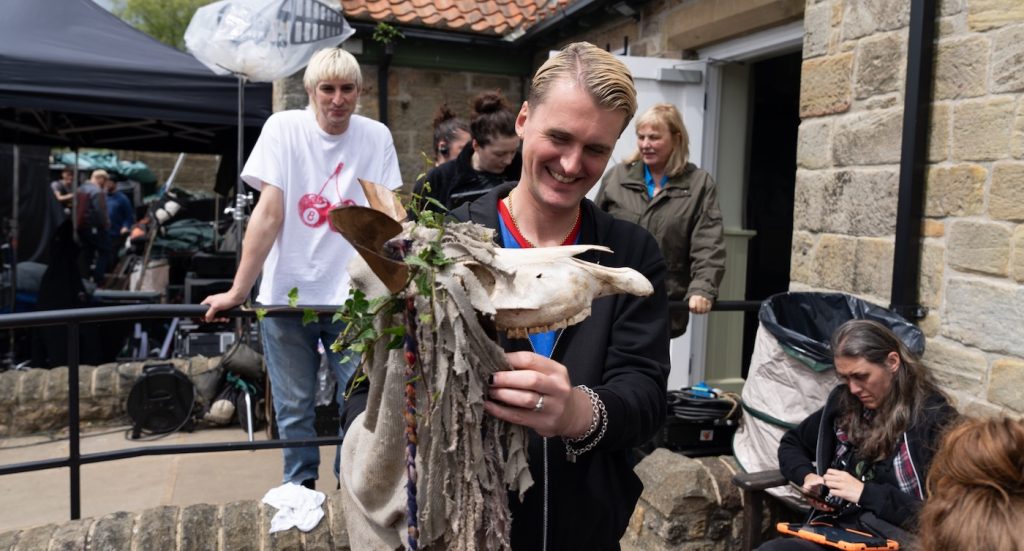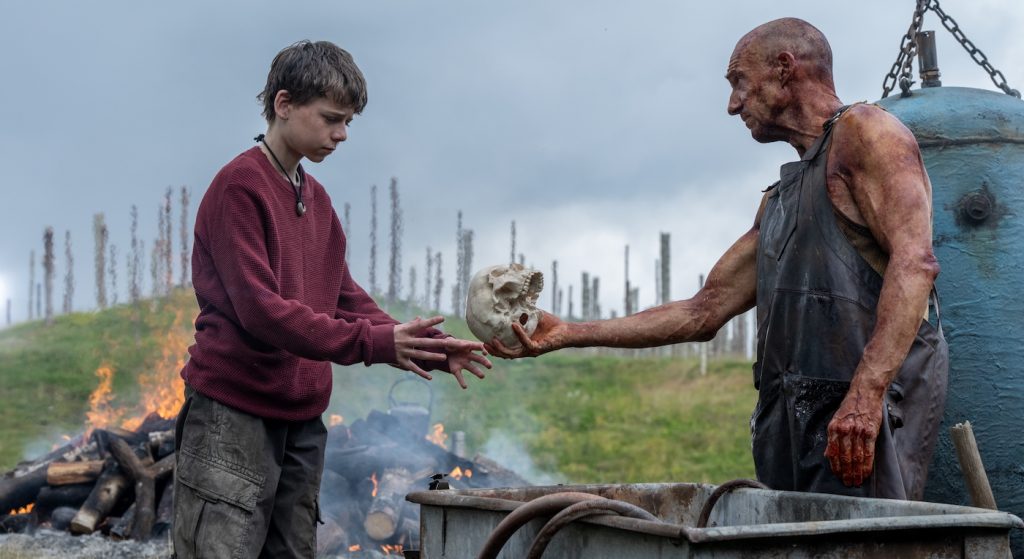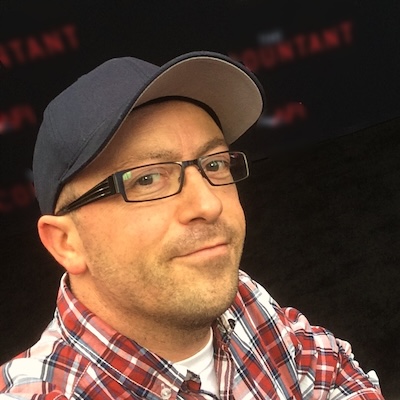Inside the Bone Temple: How Designers Carson McColl & Gareth Pugh Crafted the Pagan-Apocalyptic World of “28 Years Later”
Serving as both production designers and costume designers for director Danny Boyle’s 28 Years Later was a groundbreaking career moment for Carson McColl and Gareth Pugh.
Not only is the post-apocalyptic coming-of-age horror film the first film they have worked on, but the married couple, known as Hard and Shiny, is best known for their high fashion and for having worked with such icons as Beyoncé and Lady Gaga. They have worked with Boyle before, but this was a whole new ball game.
Set in 2002, 28 Years Later focuses on survivors of the virus who live on a small island connected by a heavily protected tidal causeway. Young Spike, played by Alfie Williams, leaves the island and discovers secrets and horrors that change everything. The film also stars Aaron Taylor-Johnson and Jodie Comer as his parents, Jaime and Isla, and Ralph Fiennes as Dr. Kelson. The rage virus has mutated and evolved, and the hardy survivors who have made it this far have done so by becoming as ruthless and cunning as possible. It’s a Darwinian world to the absolute extreme.
Here, McColl and Pugh discuss thrifting for period costumes and how they created key looks, the rich seam of talent in the North East of England, and making the model for the iconic Bone Temple with skewers from a cookware store.
Much of your previous work has been forward-thinking and futuristic, but 28 Years Later is in the past. Was that part of the challenge for you?
Gareth Pugh: It was. In our fashion work, we aim to create a sleek, graphic, and sharp aesthetic. Everything is done by hand, but we always strive for it to look almost machine-made. 28 Years Later was the polar opposite. We had numerous conversations with Danny in the beginning, and his primary driving factor was the idea of believability. The clock stopped in 2002, and the islanders’ access to clothing was limited. Vanity goes out the window, and everything has to have a function.
Carson McColl: What Danny saw in our work was that we know how to tell a story. Danny is an anarchist, and bringing us into this movie, this beloved universe that he created with Alex, was a bold move. He wanted a dynamic change to the visual approach, and when you come in as outsiders, you often challenge the status quo and push things in a new direction. He wanted that visceral energy that we bring to our work.

You oversaw costume design and production design. How did that change your process?
McColl: Many people told us how unusual that was, but it seems so natural. You’re working with fabrics and colors, as well as with the actors, to tease out the pools of meaning beneath their characters. Then, working on the sets, you’re creating the spaces in which the story unfolds. When we had doubts about a costume idea, working on the set helped us understand what it should be.

Did you scour thrift stores for period pieces that would make sense for 2002?
Pugh: That’s my favorite thing to do, so it was a pleasure. If you hire costumes, you can’t do anything to them. We have to send it back to the company in the same condition you got them, so hiring wasn’t part of our approach. There were a lot of custom-made outfits, including Spike’s, Isla’s, and Jamie’s, but we had to clothe 150 survivors on the island. There are a lot of charity shops in the North East of England and they got a lot of business out of us. At the end of filming, we donated any items that weren’t severely damaged or items that we had purchased but not used back to charity. The other challenge was multiples, which, in the world of fashion, isn’t something that we have to do. If you’re creating these incredibly detailed costumes with a lot of hand work, especially for the principals and later in the film for the Jimmys, and there’s a lot of stunts, and blood work, then the number of multiples required is crazy. With the Jimmys, each costume had its own pattern for where the stitches had to go. Those costumes were a nightmare. The guys who were working with us were incredibly skilled. It felt like working on couture, which was fun to bring into the world of film.
Could you tell me a little bit about the talent pool in the North East of England?
McColl: There are some incredible people based there. We work with a particular individual who appears in the film. He was very Holy Island in his look. He is an amazing leather worker called Jez Hunt. He appears in the movie at the very beginning, working in a bow-making workshop. He made all of the masks. We had a conversation with Danny about this regressive society, which has a real oddness to it and a Wicker Man vibe. Jez was just based down the road from us in Newcastle. Without those people and their skills, the film would have been very different.
Was there a key costume, and when you nailed that, everything else would fit into place?
McColl: Isla was a really important character. She’s not on screen as much as other characters, but reading the scripts very early on, we felt the clue is in the name. She represents this island community, so we wanted to ensure that we got her right. If we managed that, it would help inform and feel the design for the other characters, and Spike in particular. Our studio walls were covered in Isla prints. We collaborated with our costume illustrator, Melissa Mehrtens, to develop a print that felt appropriate to her story. She came up with the idea of plants that represent different things and inform that tie back to Isla’s story. It was one of the first looks we created, and when we saw her on paper, everything else fell into place.

Pugh: The film is essentially Spike’s story, so the whole thing had to revolve around him. Alfie was a very inquisitive kid to work with and was asking a lot of questions. Danny was insisting he understood everything about why things were being put on him. He always wears these Hag stones, which are colloquially associated with Lindisfarne and Northumberland. It’s a stone with a hole in it and quite a talismanic thing, almost like a portal, which we thought was a good representation of this journey between the island and the mainland. It’s also reflective of that journey between childhood and adulthood. Ralph Fiennes is a very fastidious and detail-oriented individual, and Danny was very insistent about the idea of a visually complex character for Dr. Kelson. He does take on a comedic role sometimes in the film; he’s very campy in certain moments, and Danny felt that this pajama-esque vest and long johns were basic but appropriate. He’s hanging out at his home in the Bone Temple and not expecting any visitors.

The Bone Temple is its own character in the film. How did you develop that?
Pugh: We knew very early on how important getting this set piece right was to the visual success of the film. We went through numerous iterations and began by examining structures that could have already existed within the landscape, such as pylons or cooling towers, which are quite distinctive British totems of industry. Cooling towers were being knocked down at a rate of knots, and they’re very dangerous, so Danny didn’t like the idea. We went back to the drawing board and again looked at something very British, leaning into the idea of a pagan, Henge-like structure. We created an initial model using skewers from Nisbets, a cookware shop located on Shaftesbury Avenue, near our studios in London’s Covent Garden. It was a circular structure created by a series of degradation of uprights. There was something quite beautiful in its simplicity. It looks like a giant sundial. There’s an idea of momentum, and we had numerous conversations about the passage of time, death, and life.
McColl: Something no one knows about the Bone Temple is that during lockdown, we were going through videos where you can go to places in the world, because you couldn’t leave your house, and one of the places we saw was the Hill of Crosses in Lithuania. We showed Danny a picture of it and he was so keen that we flew there two days later, with him, Bernard Bellew, the producer, and Camilla Stephenson, the location supervisor. When we got there, it was seven o’clock in the morning, snowing, and we were all alone. I think that’s when Danny decided, ‘Okay, it has to be built in real life.’ I had actually forgotten about that.
28 Years Later is in theaters now.
Featured image: Dr. Kelson (Ralph Fiennes) in Columbia Pictures’ 28 YEARS LATER.



